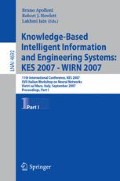Abstract
In this paper some heuristic algorithms for rough classification are presented and verified by using statistical tests. The results of these tests allow finding our which algorithm is more effective and should be applied in E-learning systems for redefining the classification criterion for the set of learners.
This work was partially supported by the Polish Ministry of Science and Higher Education under the grant no N516 013 32/1733 (2007-2008).
Access this chapter
Tax calculation will be finalised at checkout
Purchases are for personal use only
Preview
Unable to display preview. Download preview PDF.
References
Brusilovsky, P.: Methods and techniques for adaptive hypermedia. User Modeling and User-Adapted Interaction 6(2-3), 87–129 (1996)
Brusilovsky, P., Schwarz, E., Weber, G.: ELM-ART: An intelligent tutoring system on World Wide Web. In: Lesgold, A., Frasson, C., Gauthier, G. (eds.) ITS 1996. LNCS, vol. 1086, pp. 261–269. Springer, Heidelberg (1996)
Brusilovsky, P.: Adaptive and Intelligent Technologies for Web-based Education. In: Rollinger, C., Peylo, C. (eds.) Künstliche Intelligenz, Special Issue on Intelligent Systems and Teleteaching, vol. 4, pp. 19–25 (1999)
Brusilovsky, P.: Adaptive Educational Hypermedia. In: A summary of an invited talk at PEG’01 conference. In: Proceedings of Tenth International PEG conference, Tampere, Finland, June 23-26, pp. 8–12 (2001)
Heift, T., Nicholson, D.: Web Delivery of Adaptive and Interactive Language Tutoring. International Journal of Artificial Intelligence in Education 12(4), 310–325 (2001)
Kelly, D., Tangney, B.: Predicting Learning Characteristics in a Multiple Intelligence Based Tutoring System. Intelligent Tutoring Systems, 678–688 (2004)
Kobsa, A., Koenemann, J., Pohl, W.: Personalized Hypermedia Presentation Techniques for Improving Online Customer Relationships, The Knowledge Engineering Review, vol. 16(2), pp. 111–155. Cambridge University Press, Cambridge (2001)
Kukla, E., Nguyen, N.T., Daniłowicz, C., Sobecki, J., Lenar, M.: A model conception for optimal scenario determination in an intelligent learning system. ITSE - International Journal of Interactive Technology and Smart Education 1(3), 171–184 (2004)
Matusiewicz, Z.: Computer technology in teaching fuzzy sets, Varia Informatica. Obliczenia matematyczne. red: Grzegórski, S., MiŁosz, M., Muryjas, P.(eds.) PTI Lublin (2006)
Melis, E., et al.: ActiveMath: A Generic and Adaptive Web-Based Learning Environment. International Journal of Artificial Intelligence in Education 12, 385–407 (2001)
Mitrovic, A., Hausler, K.: Porting SQL-Tutor to the Web, K. In: Gauthier, G., VanLehn, K., Frasson, C. (eds.) ITS 2000. LNCS, vol. 1839, pp. 37–44. Springer, Heidelberg (2000)
Nguyen, N.T.: Advanced Methods for Inconsistent Knowledge Management. Springer, London (2007)
Nguyen, N.T., Sobecki, J.: Determination of User Interfaces in Adaptive Systems Using a Rough Classification based Method. New Generation Computing 24(4), 377–402 (2006)
Pawlak, Z.: Information systems- theoretical foundation, Wydawnictwo Naukowo-Techniczne, Warszawa (1983)
Pawlak, Z.: Rough classification. Int. J. Human-Computer Studies 51, 369–383 (1999)
Peylo Ch, T.T., Rollinger C, G.H.: A web-based intelligent educational system for PROLOG. In: Gauthier, G., VanLehn, K., Frasson, C. (eds.) ITS 2000. LNCS, vol. 1839, Springer, Heidelberg (2000)
Rutkowska, D., Piliński, M., Rutkowski, L.: Neural Networks, Genetic Algorithms and Fuzzy Systems. Wydawnictwo Naukowe PWN, Warszawa (1999)
Weber, G., Kuhl, H.Ch., Weibelzahl, S.: Developing Adaptive Internet Based Courses with the Authoring System NetCoach. In: Reich, S., Tzagarakis, M., de Bra, P. (eds.) Hypermedia: Openness, Structural Awareness, and Adaptivity, pp. 226–238. Springer, Berlin (2001)
Author information
Authors and Affiliations
Editor information
Rights and permissions
Copyright information
© 2007 Springer-Verlag Berlin Heidelberg
About this paper
Cite this paper
Kozierkiewicz, A., Nguyen, N.T. (2007). The Statistical Verification of Rough Classification Algorithms. In: Apolloni, B., Howlett, R.J., Jain, L. (eds) Knowledge-Based Intelligent Information and Engineering Systems. KES 2007. Lecture Notes in Computer Science(), vol 4692. Springer, Berlin, Heidelberg. https://doi.org/10.1007/978-3-540-74819-9_30
Download citation
DOI: https://doi.org/10.1007/978-3-540-74819-9_30
Publisher Name: Springer, Berlin, Heidelberg
Print ISBN: 978-3-540-74817-5
Online ISBN: 978-3-540-74819-9
eBook Packages: Computer ScienceComputer Science (R0)

